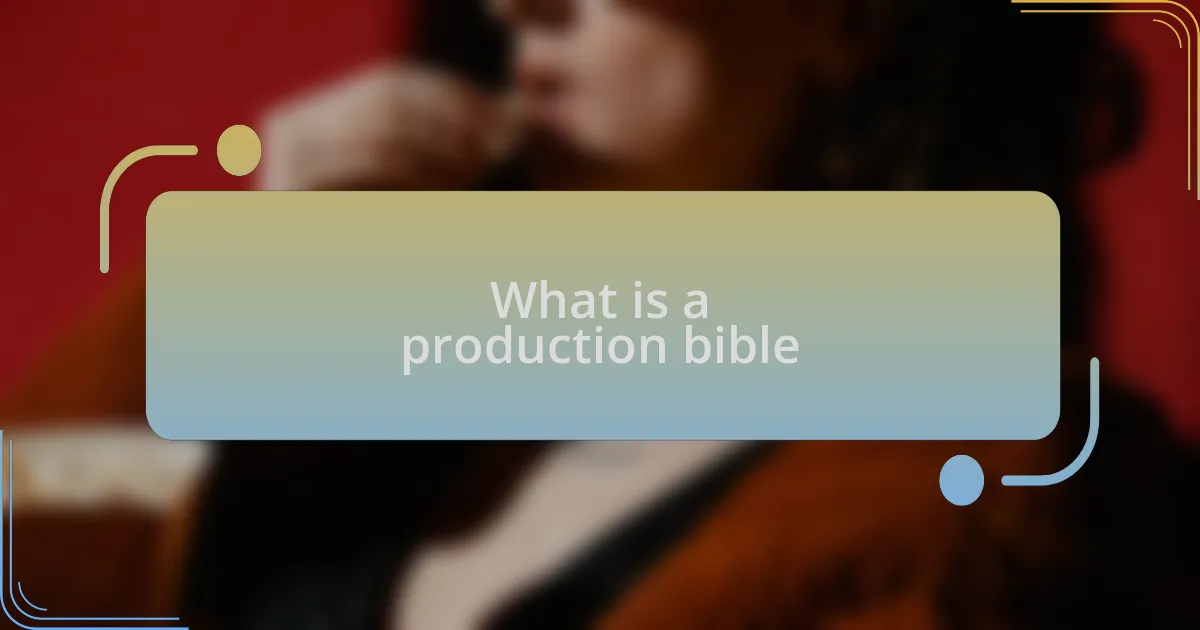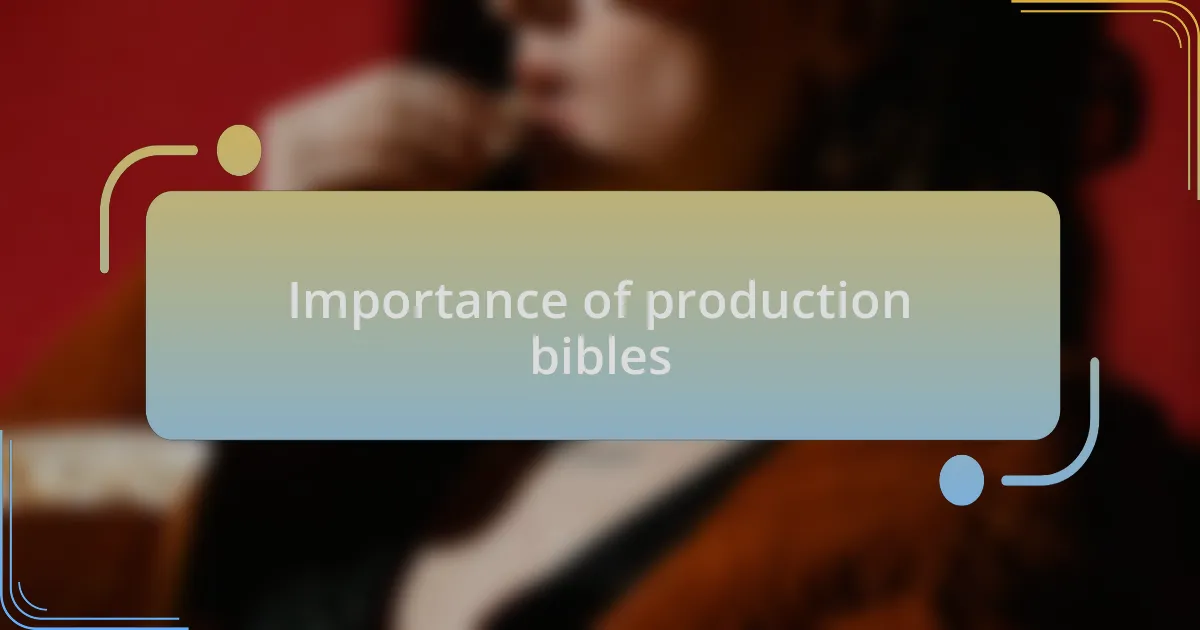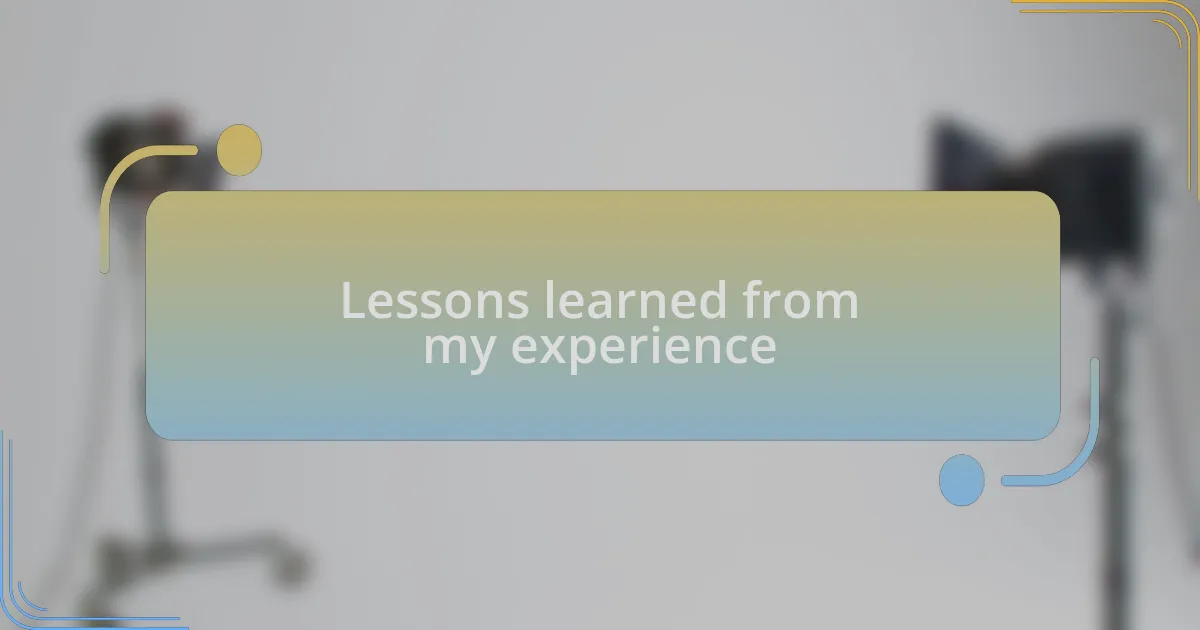Key takeaways:
- A production bible is a comprehensive guide that encompasses the creative vision, logistical details, and production strategies for film and television projects.
- It serves as a vital communication tool, promoting clarity and collaboration among the entire production team.
- Flexibility and adaptability in creating a production bible enhance the project’s depth and allow for creative evolution.
- Regular updates and team contributions significantly improve the quality and effectiveness of the production bible.

What is a production bible
A production bible is essentially a comprehensive reference guide that outlines every aspect of a film or television project. It acts as a blueprint that brings together the creative vision, logistical details, and production strategies in one cohesive document. Imagine having a central place where you can turn to for character details, story arcs, shooting schedules, and even budget projections—this is the powerful role of a production bible.
From my experience, I’ve found that the process of creating a production bible is not just about compiling information; it’s also a journey of discovery. I remember working on a pilot script that initially felt scattered until I started assembling its production bible. As I laid out character bios and connections, it felt like the project transformed before my eyes, adding layers of depth I hadn’t realized were missing. How often do we overlook the importance of organization in our creative processes? This is a crucial step that can elevate our stories from good to great.
Furthermore, a well-crafted production bible serves as a communication tool among the entire team, ensuring everyone is on the same page. It’s not just for the director or the writers; I’ve seen how grips, costume designers, and even actors benefit from having clear access to the project’s vision and expectations. Have you ever felt lost on set, unsure of how your role fits within the larger narrative? A production bible can eliminate that confusion, providing clarity and confidence for everyone involved.

Importance of production bibles
Working on a production bible has taught me that it’s much more than a guide; it’s the heartbeat of a project. It continuously reminds us of our goals and direction. There were times when I felt overwhelmed during shoots, but the production bible served as my anchor, a constant reminder of our shared vision that kept the team aligned.
Another essential aspect is how it fosters collaboration. During one project, I vividly remember when the art department and costume designers accessed the bible to understand the characters’ backgrounds. This exchange led to creative brainstorming sessions that enriched our visual storytelling. Have you ever noticed how such collaboration can breathe fresh life into a script? A well-crafted production bible encourages that synergy.
Furthermore, having a production bible streamlines decision-making processes, especially in a fast-paced environment. I recall a crucial shooting day when we had to make quick adjustments due to weather changes. Because we had a clear outline in the bible, we adapted without losing sight of our original vision. Isn’t it reassuring to have a roadmap that helps navigate the unexpected twists of production?

Tips for making it effective
To make your production bible truly effective, I suggest starting with a clear and concise vision statement. This statement should encapsulate the essence of your project, much like its mission. I recall one project where we defined our vision early on, and it provided clarity during moments of indecision. Wouldn’t you agree that having that core message can help everyone stay on track?
Another tip is to include visual references, like mood boards or character sketches. I once added a visual element for a character that sparked an inspiring discussion with my team about the tone of their journey. It became a creative springboard, allowing us to explore ideas we might not have touched on otherwise. How often do we overlook the power of visuals in conveying our concepts?
Lastly, don’t underestimate the power of regular updates. Early in my career, I learned that sharing incremental changes made a world of difference. I remember revising sections as we went along, and it kept the team engaged and invested. Have you tried this approach? I found that involving everyone in the revision process deepened their commitment to the project.

Lessons learned from my experience
One major lesson I’ve learned is the importance of adaptability. When I first started creating production bibles, I had a rigid structure in mind that I stubbornly followed. However, I quickly realized that embracing flexibility allowed my projects to evolve in unexpected and exciting ways. Have you ever clung too tightly to a plan that didn’t serve your vision?
Another realization came from collaboration. I used to think that my role was primarily to outline the framework myself, without much input from others. Yet, the moment I opened the floor for contributions from my team, the quality and creativity of our production bible skyrocketed. It was eye-opening; everyone brings unique perspectives that enrich the project.
Lastly, I’ve learned to view feedback as a valuable resource rather than criticism. Early on, I approached feedback defensively, but with time, I discovered it can illuminate blind spots I hadn’t considered. I vividly remember a time when a colleague’s constructive criticism led us to refine our character arcs beautifully. Have you allowed yourself to learn from others in a similar way?